Mexican-style South of the Border Justice has arrived in America with a vengeance, and is on display in a courtroom in Miami where three members of New York’s Gambino Family, Anthony “Big Tony” Moscatiello, Anthony “Little Tony” Ferrari, and James “Pudgy” Fiorello, are on trial for the murder of Suncruz Casino tycoon Gus Boulis.
The Boulis trial confirms the appearance on these shores of the kind of blatant immunity from prosecution that Mexican gangsters, politicians, drug cartel bosses and Generals—many of whom wear more than one hat—have long taken for granted in our neighbor to the South. Given the continuing devolution of the formerly-great superpower, this should not be considered an especially surprising development.
Yet it is still a shock to realize how much justice in today’s Miami resembles that in, say, Tijuana, fabled home of risque sex acts and now “stewmasters” making “Mexican meat soup” by dissolving bodies in 55-gallon industrial drums in auto repair shops placed strategically across the dusty landscape.
Tijuana is located in a semi-failed state that you could call a banana republic, if that weren’t a slur on nutritious fruit.
Guess what? So is Miami.
Inconvenient men
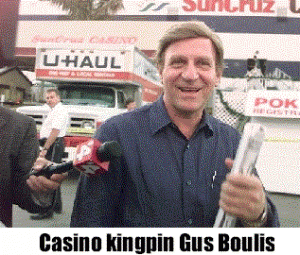 Maybe Miami and Tijuana should be sister cities. Because Gus Boulis’ murder trial is almost too spookily similiar for words to a trial which took place in Tijuana twenty years ago.
Maybe Miami and Tijuana should be sister cities. Because Gus Boulis’ murder trial is almost too spookily similiar for words to a trial which took place in Tijuana twenty years ago.
Gus Boulis was a casino cruise operator who had recently sold his 11-ship operation to Jack Abramoff, the big-time Republican lobbyist who was at the time one of America’s most powerful men. After Abramoff and Kidan “forgot” to pay Boulis for the purchase of his casino cruise line, his continued existence almost instantly became inconvenient.
Héctor Félix Miranda was a well-known journalist in Tijuana. When he wrote something unflattering about one of Mexico’s most powerful men, his continued existence also became inconvenient.
Both suffered the same fate, in the same way. Also, the aftermath of the murders played out almost identically.
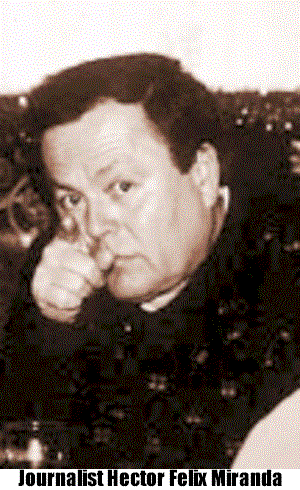 Hector Felix Miranda was ready to go to work. On a rainy morning in April, 1988, he left his house and climbed behind the wheel of his Crown Victoria LTD to drive to his job as co-editor of ZETA, a widely-read muckraking newspaper.
Hector Felix Miranda was ready to go to work. On a rainy morning in April, 1988, he left his house and climbed behind the wheel of his Crown Victoria LTD to drive to his job as co-editor of ZETA, a widely-read muckraking newspaper.
Across the street from Hector that morning sat a man watching from a black Pontiac TransAm with its engine running. Victor Medina was a burly former state policeman, an expert marksman, and a professional bodyguard to Jorge Hank Rhon, the son of Carlos Hank González, the most powerful man in Mexico at the time.
Parked facing Hector, maybe 150 feet away, was a brown Toyota pickup truck with two men aboard. One wore Levis and work boots, while the other, the shooter, Antonio Vera Palestrina, who had been Carlos Hank González’ personal bodyguard when Hank was Mexico City’s mayor, was decked out in cowboy boots, cowboy hat, an expensive suit, and a belt with a gold belt buckle.
The black TransAm pulled out in front of Hector, then suddenly stopped. Coming up behind him was the brown Toyota pickup, which pulled up beside Hector.
“A dog-watching, food-fetching, car-washing wanna-be Mobster”
 Gus Boulis was ready to go home. Finished with a later meeting that lasted until 9:15 p.m. on a cool breezy night in February 2001, he walked outside to his BMW, and pulled out of the parking lot and turned south, towards home.
Gus Boulis was ready to go home. Finished with a later meeting that lasted until 9:15 p.m. on a cool breezy night in February 2001, he walked outside to his BMW, and pulled out of the parking lot and turned south, towards home.
Watching Boulis drive away, according to his testimony at the trial, was James “Pudgy” Fiorillo, described as a “dog-walking, food-fetching, car-washing, and baby-sitting wanna-be Mobster from New Jersey.” Pudgy got his nickname back in high school, where he stood 5’6” while weighing 260 pounds.
Prosecutors used to think Pudgy had been the gunman who killed Boulis. But they accused him only of spying on Boulis and reporting his movements to “Little Tony” Ferrari on the night of the murder. Two years ago, he pled guilty to murder and conspiracy charges, and got a light sentence in return for testifying for the prosecution.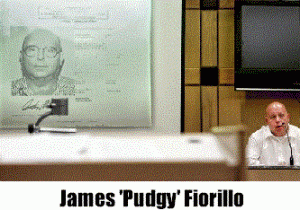
Boulis had only driven a few blocks before a car pulled in front of his BMW, forcing him to slow down, and then stop. The car in front of him didn’t budge. Boulis slammed on the brakes to avoid a collision. Just then, witnesses told police, a second car, a black Mustang drove up and pulled alongside him in the oncoming lane.
The Mustang’s driver opened his window. Boulis turned to look, and made a grim discovery. The man in the Mustang was pointing a gun right at him. Boulis raised his hand as if to shield himself, but it wasn’t enough to stop three hollow-tip bullets from burrowing deep inside his chest when the driver opened fire, shooting Boulis at least three times with a semi-automatic weapon.
As the black Mustang front of him sped away, Boulis screamed, a loud blood-curdling animal sound that eyewitnesses said they will never forget. Bleeding and barely conscious, Boulis pressed the accelerator, headed south a few blocks, then turned a corner and blacked out, spinning across a median into oncoming traffic and crashing into a tree next to a Burger King.
On a street in Tijuana in a light rain
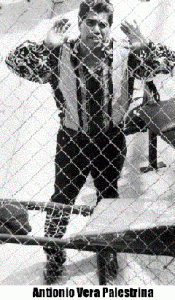 Professional bodyguard Antonio Vera Palestrina rolled down his window and pulled out a powerful shotgun and shot Hector twice.
Professional bodyguard Antonio Vera Palestrina rolled down his window and pulled out a powerful shotgun and shot Hector twice.
The impact of the first shot threw Hector off his seat to the other side of the car, where his head bounced off the door as a second shot pierced his ribs, ripped his arm and almost tore it away. His body was left slumped under the dashboard, his gray “Members Only” jacket shredded, smelling of gunpowder, and soaked in blood and flesh.
In Tijuana, there were daily demonstrations. The public and independent newspapers across Mexico expressed skepticism of the investigation into Hector’s murder, and called for justice. “Unless politics or publicity interferes, money can buy innocence and freedom,” explained a journalist in Mexico City.
Authorities in Mexico soon arrested the two Jorge Hank Rhon bodyguards, Medina from the TransAm, and Vera from the Toyota pick-up truck, who they also identified as the shooter.
Despite persuasive evidence to the contrary, prosecutors theorized Vera’s motive for murdering the journalist was rage over something Hector had written about him. This mystified Hector’s co-workers at the newspaper, who could find no evidence that Hector had ever even mentioned him in his column.
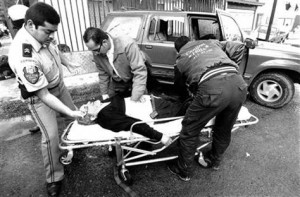 Jorge Hank Rhon was known to have been incensed about Hector’s last columns, in which Hector had ridiculed him as a spoiled rich kid. Yet the relationship between Hector and Rhon went unexplored. The bodyguards’ boss, Jorge Hank Rhon, was never even questioned.
Jorge Hank Rhon was known to have been incensed about Hector’s last columns, in which Hector had ridiculed him as a spoiled rich kid. Yet the relationship between Hector and Rhon went unexplored. The bodyguards’ boss, Jorge Hank Rhon, was never even questioned.
And, most tellingly, on the day of the murder Vera—who was Jorge Hank Rhon’s head of security as well as his personal bodyguard—had cashed a $10,000 check from Rhon at Rhon’s Aqua Caliente racetrack.
Despite these major loose ends, authorities began to act as if the crime had been solved. There was an inexplicably long delay before the trial began, during which it was continually postponed. Slowly, the story began to disappear from newspapers. People no longer demonstrated. Journalists stopped showing up at noon every day outside the prosecutors office demanding justice.
When the trial finally commenced, witnesses had become considerably less certain of their facts than before.
Something wicked–and highly irregular–this way comes
 After Greek tycoon Gus Boulis was gunned down in his BMW, Fort Lauderdale police immediately began scrutinizing SunCruz Casinos. Suspicion focused on the recent sale of his casino fleet, for a very good reason: Boulis, Jack Abramoff, and Adam Kidan had been carrying on a very public feud.
After Greek tycoon Gus Boulis was gunned down in his BMW, Fort Lauderdale police immediately began scrutinizing SunCruz Casinos. Suspicion focused on the recent sale of his casino fleet, for a very good reason: Boulis, Jack Abramoff, and Adam Kidan had been carrying on a very public feud.
“We certainly aren’t lacking in suspects,” said a Fort Lauderdale homicide detective with admirable understatement.
Later, detectives said they had basically solved the crime within 48 hours. However, they offered no explanation for why it took four years before three men who they had believed were involved in the murder since the day after the crime were finally arrested and charged.
Nor have prosecutors, since the trial began two weeks ago, taken the jury into their confidence about why—after taking an impossibly slow four years to bring charges—they took an additional eight years to bring the case to trial. Safe to say, something highly irregular was clearly going on.
Adam Kidan, a defrocked attorney who had gone bankrupt in both a bagel shop and a mattress store, became Jack Abramoff’s partner in what prosecutors say was a totally fraudulent purchase of Fort Lauderdale-based SunCruz casinos from Boulis.
Kidan and Jack Abramoff partnered to buy SunCruz from Boulis for $147.5 million, then reneged on paying as soon as the deal was final. Instead of paying Boulis, Kidan and Abramoff used $300,000 of SunCruz money for a luxury skybox at FedEx Field in Washington, D.C., where Abramoff entertained politicians and GOP fat cats.
Abramoff and Kidan also helped themselves to $500,000 salaries, as well as lots of expensive perks. But the best part of the deal was that the two men took control of the casino line without ever putting down a dime of their own money.
No wonder Boulis was suing to regain control of the business when he was killed.
A really cheesy way to work off a beef
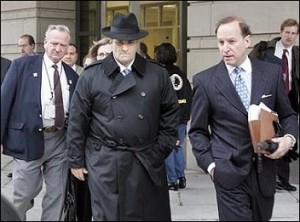 Both men were later jailed after pleading guilty to defrauding lenders in the deal. As part of his plea agreement, Kidan pledged to cooperate with federal prosecutors.
Both men were later jailed after pleading guilty to defrauding lenders in the deal. As part of his plea agreement, Kidan pledged to cooperate with federal prosecutors.
“Mr. Boulis, who owned the casino boat fleet, was shot and killed in 2001,” reported the New York Times. “Mr. Kidan may be able to help state prosecutors who are investigating the slaying of Konstantinos Boulis.”
“Mr. Kidan may be able to help prosecutors investigating the Boulis hit” is like authorities asking O.J. Simpson for help figuring out who murdered Nicole. It’s almost too droll for words. And far too ironic for the NY Times.
Now that the government shutdown is over, if you’re looking for a fresh source of outrage to bring a healthy flush to your face, try this: By stepping forward and bravely pointing an accusing finger at Gus Boulis’ “real” killer, who turned out, alas, and all too conveniently, to be already dead, Adam Kidan got his federal prison sentence cut… in half.
Despite having a string of well-documented character defects that mark him as a prime candidate for an invitation to Michael Milken’s Sociopaths Ball, somebody in our government clearly wanted Adam Kidan to really really like him.
Eleven unregulated casinos trump “lucrative bodyguard contracts.”
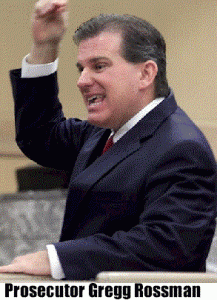 In an opening statement lasting over an hour, prosecutor Gregg Rossman described a scenario right out of a Hollywood movie — shady financial deals, powerful Washington D.C. interests, mob figures, convicted felons…All he left out was the real reason for the terrifying end of one of South Florida’s most prominent businessmen.
In an opening statement lasting over an hour, prosecutor Gregg Rossman described a scenario right out of a Hollywood movie — shady financial deals, powerful Washington D.C. interests, mob figures, convicted felons…All he left out was the real reason for the terrifying end of one of South Florida’s most prominent businessmen.
Prosecutors said they “didn’t believe” Kidan or Abramoff played any role in the murder of Boulis.
Because I found the statement so amazingly unbelievable, I collected examples of how various national newspapers had phrased it.
“Abramoff had nothing to do with Boulis’ death,” said prosecutor Brian Cavanaugh, in a straighforward, if unconvincing, explanation. He went on to say he can understand why defense lawyers would want to look into it. “They have a right to investigate their case,” Cavanaugh said. “They perceive things differently than we do.”
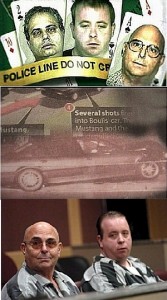 “Prosecutors said they believe Moscatiello, Ferrari and Fiorillo had Boulis killed without Kidan’s knowledge,” read another, “then pressured the lad to continue paying protection money.”
“Prosecutors said they believe Moscatiello, Ferrari and Fiorillo had Boulis killed without Kidan’s knowledge,” read another, “then pressured the lad to continue paying protection money.”
Elsewhere, prosecutors theory of the case suggested the Goombah Gambinos had killed Boulis to “encourage” Kidan to keep paying protection money.
“According to prosecutors, “Big Tony” Moscatiello saw Kidan and SunCruz as a continuous income stream. Boulis was a threat to that income. Boulis’ attempt to regain control over SunCruz, threatened lucrative contracts they had with the new owners.”
The prosecutor’s reasoning made no sense. Compared to the real stakes involved in controlling SunCruz, the Gambino torpedoes bodyguard contracts were strictly penny ante. Also, since Kidan was ostensibly paying for their bodyguard services because he was worried about being “rubbed out’ by Boulis, wouldn’t eliminating the threat posed by Boulis also eliminate the need for the “lucrative” bodyguard contract?
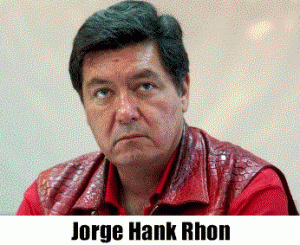 Recall for a moment Tijuana prosecutors claim that Jorge Rhon’s bodyguard killed journalist Hector Felix over something the journalist hadn’t written about him. Jack Abramoff and Jorge Hank Rhon must have something powerfully compelling in common.
Recall for a moment Tijuana prosecutors claim that Jorge Rhon’s bodyguard killed journalist Hector Felix over something the journalist hadn’t written about him. Jack Abramoff and Jorge Hank Rhon must have something powerfully compelling in common.
Determined to shield jurors from realizing that the people responsible for ordering the murder of Gus Boulis are not sitting in the dock—and never will be—prosecutors since the trial began have engaged in tortured reasoning that would be right at home in courtrooms in Tijuana.
They believe the gunman who shot Boulis to death was a man named John Gurino, who was killed in a dispute with a Boca Raton delicatessen owner two years later.
Murder trumps fraud…but blackmail trumps murder
Eight years ago, some believed the Florida State’s Attorney’s Office was about to charge Jack Abramoff and Adam Kidan, then on trial for fraud for stealing the SunCruz line through blatant financial fraud, in the murder of Gus Boulis.
Wrote one optimistic pundit, “Murder trumps fraud in the prosecutorial world.” But neither Abramoff or Adam Kidan was ever named as a suspect. The answer to “why not Kidan?” is easy.
No one would be able to convince a jury that the buck stopped with him. (Kidan was the man, after all, who wrote checks(totaling $200,000) to pay for the hit.) That meant charging Abramoff.
The kid glove treatment both men received illustrated how little reason there was for ever believing that the result of the Abramoff Scandal would be a big broom sweeping everything clean.
The Abramoff Scandal, like the Jorge Rhon murder scandal in Tijuana, and like Iran Contra and every other recent American scandal,is deemed too big to ever be allowed to break.
Moscatiello told detectives that Kidan had ordered the hit. Prosecutors apparently don’t believe him. Anyone doubting his assertion should perform a simple thought experiment:
“You’ve just bought a life insurance policy for $10 million on your spouse, who is then shot three times at close range with hollow point rounds by people authorities identify as Gambino hit men who recently cashed big checks from you.
Is writing a quarter million dollars worth of checks (for no discernible purpose) to Mafia hit men later charged with the murder of the check-writer’s biggest enemy just another in the long line of “freak coincidences” for which Florida is justly famous?
We are apparently about to find out.

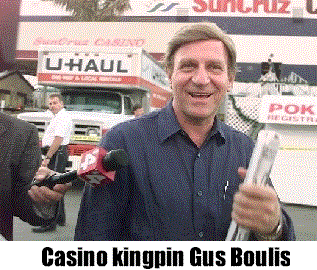
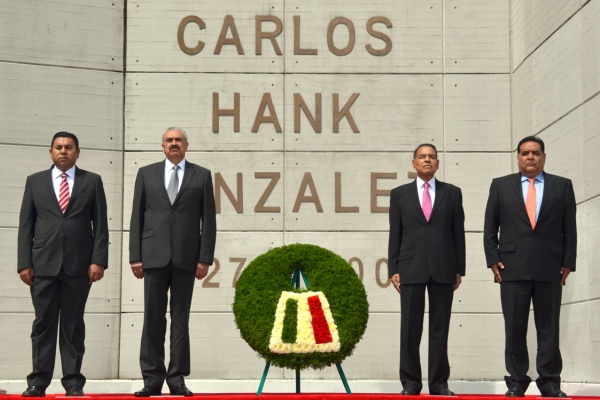
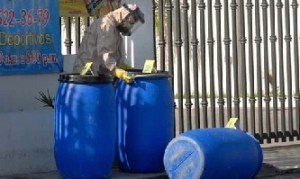

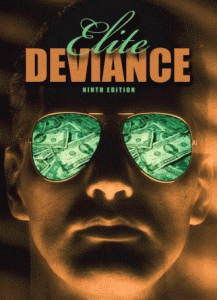
[…] Which may explain The Mexican-ization of American Justice. […]
[…] Hopsicker on the SunCruz mob/murder/republican trial happening in Florida: […]
[…] brilliant for the pin-up-the-ass honky goys at Justice.” Haters! In a beautiful piece called “The Mexicanization of American Justice,” one angry gadfly mulls in detail a mob whack some years ago that has Abramoff’s mitts all […]
To bad Charles Manson wasn’t tried in either venue as the outcome of his infamous case might have been different, but probably not. He lacked powerfully twisted friends in high places.
Incidentally, a connection between Jeb Bush and the Rhons that may interest you.
Jeb Bush served on the board of Halmos’s Ideon Group
Halmos was some sort of operative for the Rhon family:
http://www.elandar.com/back/spring01/stories/story_entrapment.html